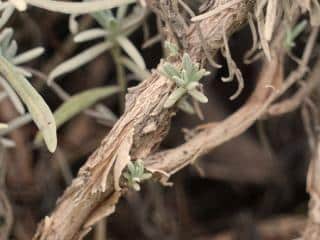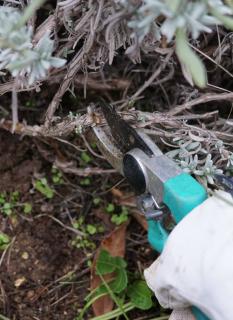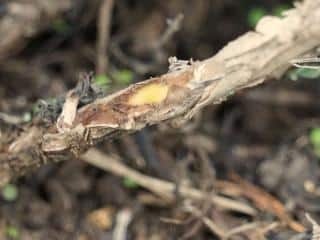Lavender plants grow old and woody after 6 to 10 years. Through staged hard pruning, restore old wooden lavender to a nice, round shape!
Hard pruning lavender facts:
Success rate – rather low
Difficulty – high
Time – 3 to 4 years
Season – spring
Cutting lavender back hard in one go will kill the plant. You have to spread this work over three years.
→ Avoid this with regular lavender maintenance pruning
Hard pruning of lavender
Usually, old lavender is replaced. However, many of us grow attached to the plants we care for. Perhaps they were a gift, or were planted by a person we cherish. We’re loathe to just pull it out without even trying!
Risks of hard pruning on lavender
The plant might not survive. This isn’t due to any particular mistake or bad luck. It’s just that lavender doesn’t cope with hard pruning well.
- New branching requires lots of sap circulation.
- Cutting leafy tips off and leaving only woody stems behind stops sap circulation.
- Small sprouts and buds can’t pull nutrients and water up and die off.
Staged pruning in a nutshell
Staging the hard pruning over three years (or even four) makes it easier on the plant.
The goal is to strike a delicate balance.
- On one hand, hard pruning is necessary to reduce shrub size.
- On the other, you protect the plant from severe pruning shock.
 You can trigger new shoots from around the base by following these steps:
You can trigger new shoots from around the base by following these steps:
- Let light enter to the center of the plant.
- Wait for sprouting along older woody stems, without cutting their leafy bits off at first.
- When sprouts are vigorous enough, shorten older stems to reduce and rejuvenate the shrub.
How to hard-prune lavender
- An initial, light, maintenance pruning is performed on the entire shrub.
- Every year after that, one third of the long, woody branches are cut back to the trunk.
Maintenance pruning
After that, while still in year 1
- Cut one in three stalks back all the way back to the trunk. This creates holes in the shrub, which lets light reach the center.
- For each remaining stem, cut growth back to leave only 2-3 inches of green leaves (7-10 cm). Practically, this means cutting tips off but leaving 4-5 pairs of leaves on each stem.
- If winters are harsh in your area, protect your lavender from the cold.
Year 2 – second round of severe pruning
 Normally, a few shoots will emerge from the old base. They grow slowly.
Normally, a few shoots will emerge from the old base. They grow slowly.- This being the following year, cut off half of the remaining older, leggy shoots back to the trunk. This is the second “batch” of stems to be cut back totally.
- Trim all new, young shoots to half their new growth. These are your future lavender stems so you want to make sure they branch out a lot.
Keep pinching or cutting the tips off these shoots every time they reach four or five new pairs of leaves.
Year 3 – wrap up the last woody stems
- Again, more new shoots emerge, and the previous year’s shoots have branched out.
- Cut back to the trunk any remaining old, woody stems.
- From then on, simply perform regular lavender trimming every year.
- You should be set for another decade!
How to improve the success rate
Spread the work over four years instead of three
This means you’ll only be removing one in four branches instead of one in three.
- It’s softer on the plant and won’t shock it as much.
Scar old wood: “young wood” grows back better
We’ve seen that one of difficulties is that young branch buds can’t appear on old wood.
If you lightly wound the trunk or large branches near the base, by scraping a very thin layer of old bark away, the plant will heal the wound.
In doing so, it will also produce new buds and branches near that spot, if it gets light.
 Remove enough bark to reveal the green, live layer of cambium cells underneath.
Remove enough bark to reveal the green, live layer of cambium cells underneath.- Don’t peel all around the branch, as this would kill it.
- Peel lengthwise from one half to one inch (1 to 3 cm) long. At most 1/4th inch wide (5 mm)
- Make several cuts on different sides and on different sections.
- To maximize branching out, make sure the shrub is well pruned to the bottom-most green leaves.
- Eventually, remove a few topside branches to let more light shine on the scars.
Layer longer branches
You can also layer lavender.
- Select two or three of the longest branches.
- Fasten them to the ground for them to root.
- Detailed instructions here (soil-layering) and here (air-layering).
Layering also takes two or three years. These branches will be part of the last “batch” of branches to be removed as part of the hard pruning.
Cuttings, of course
Hard pruning involves cutting pieces off your lavender plant.
Read also:
Smart tip about giving your lavender a hard pruning
Make lots of cuttings from the stems and twigs you collect upon pruning. You’ll have the joy of having even more plants to grow and give away!
Images: own work: Rosalyn & Gaspard Lorthiois


 You can trigger new shoots from around the base by following these steps:
You can trigger new shoots from around the base by following these steps: Normally, a few shoots will emerge from the old base. They grow slowly.
Normally, a few shoots will emerge from the old base. They grow slowly. Remove enough bark to reveal the green, live layer of cambium cells underneath.
Remove enough bark to reveal the green, live layer of cambium cells underneath.